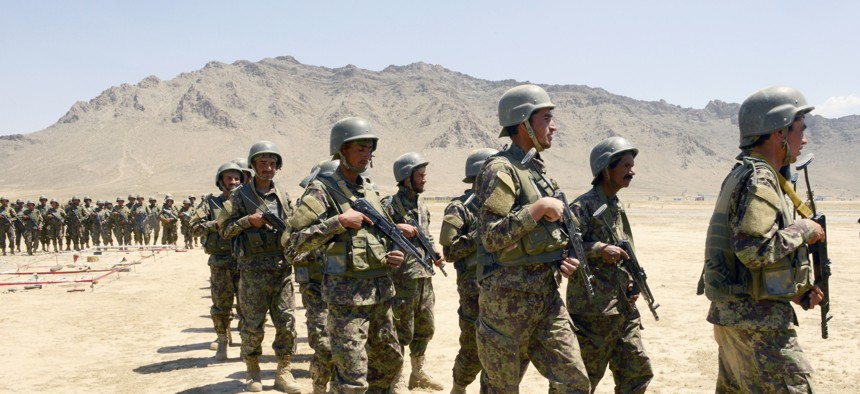
Afghan National Army-Territorial Force members prepare for an exercise at the Kabul Military Training Center in Kabul, Afghanistan, June 11, 2018. U.S. Air Force / Tech. Sgt. Sharida Jackson
In Afghanistan, Ceasefires Could Pave a Path to Peace
The overlapping, temporary ceasefires announced by the Afghan government, U.S.-led NATO forces, and the Taliban show there is still hope for a political end to the conflict.
Ten months ago, the Donald J. Trump administration announced its South Asia strategy, which largely prioritized military efforts to stabilize the stalemate in Afghanistan. Since then, thousands of additional U.S. troops have arrived in Afghanistan and U.S. military strikes against the Taliban have increased exponentially (the number of strikes was 700 percent higher in December 2017 than December 2016). Yet such efforts do not appear to have diminished the Taliban’s battlefield strength nor its ability to launch attacks in urban population centers, judging from the Department of Defense inspector general’s latest report and the spate of high-profile attacks in 2018. Despite this escalation, recent announcements of overlapping, temporary cease-fires by the Afghan government, U.S.-led NATO forces, and the Taliban are hopeful signs that there is still room to move toward a political dialogue to end the conflict.
On June 7, Afghan President Ashraf Ghani declared that the Afghan government would suspend offensive operations against the Taliban for eight days, to coincide with the Eid al-Fitr holiday marking the end of the Muslim holy month of Ramadan, and the U.S. military commander in Afghanistan affirmed that international forces would also abide by Ghani’s cease-fire. On June 9, the Taliban spokesperson announced that the group would observe a three-day cease-fire—but it would nevertheless defend itself if attacked and would continue to target foreign forces. While the conflicting terms and timelines of the cease-fire make it vulnerable to spoilers and are unlikely to lead to a sustained reduction in violence, this development is nonetheless important for three major reasons.
First, the symbolic and rhetorical significance of the cease-fire is valuable. While all parties to the conflict agree that the war cannot be won militarily, forging agreement on how to move toward a political settlement has proved an elusive goal, and all sides appear to have escalated military efforts. A temporary cease-fire linked to Eid is a low-cost opportunity for each party to publicly signal interest in building goodwill toward eventual talks. Further, a nationwide cessation in fighting is unprecedented in the history of the conflict.
Second, the cease-fire builds incremental confidence between the parties, which a recent expert report on advancing peace in Afghanistan assesses to be one of the most important near-term steps for moving toward peace. We may never know the extent to which increased U.S. targeting efforts favorably disposes the Taliban leadership to negotiate, but there is reason to believe that overtures aimed at building confidence—such as Ghani’s cease-fire announcement—may have done more to elicit the Taliban’s announcement than kinetic pressure. After all, ripeness theory suggests there are two necessary components for parties to a conflict to decide to pursue negotiations. The first is a mutually hurting stalemate, which describes the current state in Afghanistan. The second is the perception that a viable alternative path to fighting exists for each side to achieve its core goals. The recent U.S. military pressure campaign may well reinforce the stalemate, but use of confidence-building measures may signal to the Taliban that an alternative pathway to fighting exists.
Finally, U.S. and NATO support for the cease-fire and, more broadly, their willingness to support Ghani’s policies demonstrate the agency of the Afghan government over international forces. Sequencing has long been a major obstacle in moving toward negotiations. The Taliban has signaled repeated interest in negotiating with the United States before it negotiates with the Afghan government because of the Taliban’s perception that the United States ousted it from power and makes decisions that Kabul follows. Further, the Taliban is likely skeptical that the Afghan government, which has been publicly beset by divisions since taking office, will be an empowered negotiating partner. Meanwhile, the United States insists the Taliban talk to the Afghan government first. The U.S./NATO cease-fire underscores that international forces will support efforts initiated by the Afghan government that affect the Taliban.
Worrisome trends persist, including deteriorating security throughout the country and the conflict’s rising toll on Afghan civilians, but 2018 has seen some positive traction toward peace. Ghani made a tangible peace offer in February and received international support for it, the Taliban has stated interest in negotiations, and there have been positive engagements between Kabul and Islamabad. Regardless of whether the cease-fire holds, such confidence-building measures renew hope in the plausibility of moving toward a peace process that ends the conflict, which is a step in the right direction.
The author is an International Affairs Fellow at the Council on Foreign Relations, a position being sponsored by the U.S. government. All statements of fact or analysis are those of the author and do not reflect the views of the government.




